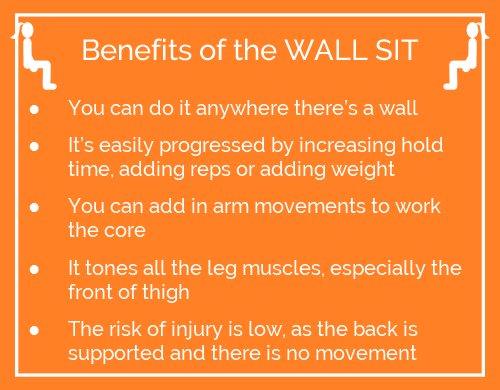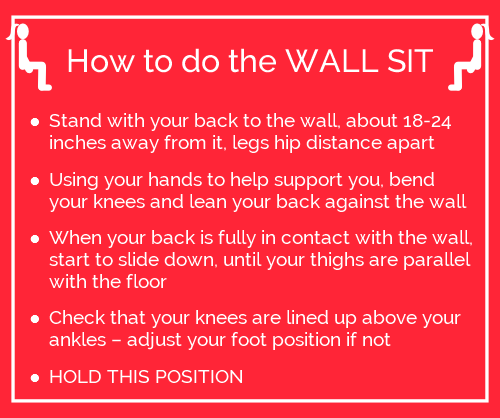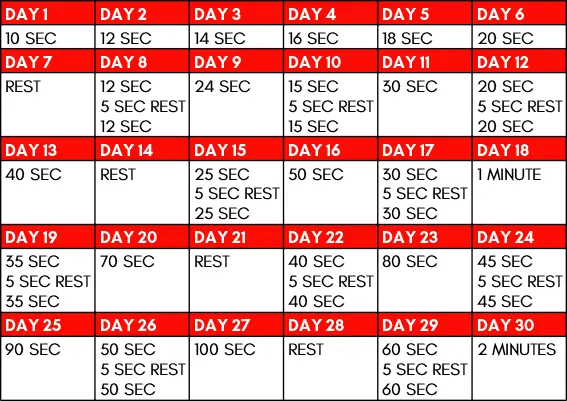The wall sit is an exercise which works all the main leg muscles, especially the large muscle group on the front of the thighs (quadriceps). In the wall sit, you have your back supported against a wall and your knees bent to 90 degrees. Then you just hold the position – the time of the hold can vary from a few seconds to several minutes. As with most fitness challenges, this 30 day wall sit challenge increases the effort slightly each day. The challenge ends on day 30 with a total of two minutes in the position. For most people, this is quite a long hold. Challenges which end up with a hold of several minutes on day 30 simply aren’t realistic unless you already do a lot of leg strength work.
Wall sit benefits

- You can do it anywhere there is a wall
- It’s easily progressed: you can increase the time held/number of repetitions, place a weight on the legs or add variations
- You can add in arm movements to work the core
- Because the back is supported, most people have no trouble getting the thighs parallel to the floor, whereas with an unsupported squat many people can’t squat so low
- It tones all the leg muscles, especially the front of thigh
- The risk of injury is low, as the back is supported and there is no movement
Disadvantages of the wall sit
- It’s a static exercise – it only trains the legs in one position (Note: static holds are not advisable for those who have high blood pressure, due to the increase in blood pressure caused.)
- It’s a strength exercise only and contributes little to cardiovascular fitness or weight control.
- Although the exercise can be progressed by increasing time held, long holds are time-consuming and boring!
In summary, it’s a good one to do if you have a few minutes to spare, your legs need a bit of toning up, or to add into your workout for variety.
Correct wall sit form

- Stand with your back to the wall, about 18-24 inches away from it, legs hip distance apart
- Using your hands to help support you, bend your knees as you lean your back against the wall
- When your back is fully in contact with the wall, start to slide down, until your thighs are parallel with the floor
- Check that your knees are lined up above your ankles – adjust your foot position if not
- The position shouldn’t be uncomfortable. If there is any discomfort in your back or knees, then check your position carefully. If you still feel discomfort, don’t do this exercise without seeking appropriate medical advice.
Coming back up again
Slide back up the wall and use your hands to push away from the wall
Wall sit workout safety notes
- Make sure you follow the instructions above to get the correct position
- For general exercise safety guidelines, see here
- Rest for longer between holds/sets if you need to
- If holding the wall sit position makes you feel dizzy or light headed stop immediately and take medical advice before attempting again
- The leg muscles will build up lactic acid and feel uncomfortable, this is normal. However, there should not be any pain in the knees or any other joints. If you feel pain, reassess your position. If you continue to feel pain, take advice from an appropriate physical therapist (physiotherapist/sports injury specialist/osteopath/sports massage therapist etc).
30 day wall sit challenge
These are the number of seconds you should hold for each day.

Progressing beyond the challenge
What do you do once you can do a 2 minute wall sit? You could carry on doing 2 minutes every day, to maintain the leg strength and muscle tone you’ve achieved. Or, you could continue to increase your hold time in order to progress further. However, this will obviously become more time consuming. A better alternative is to increase the intensity by having a weight on your thighs. Alternatively, try a different leg challenge – it’s good to have variety in your workouts. See the suggestions below for more leg workout challenges.
Related to 30 day wall sit challenge
Challenge FAQs
The first day of the challenge should feel like it needs a bit of effort, but not too much. If you really struggle with day 1, then you probably won’t get through the challenge. The idea with the challenges on this site is that the first few days get you used to the exercises and the daily habit. Usually about halfway through the challenge the effort levels start to increase more quickly.
Avoid challenges that increase effort levels very quickly – they’re simply not realistic. It’s unlikely that, for example, you would be able to increase how many squats you are able to do by 10 a day for 30 days, or increase your plank hold time by 10 seconds a day for 30 days.
In general, allowing muscles 48 hours between workouts is good because it gives our bodies time to recover and adapt. Challenges are generally short workouts and for a limited period of time (usually 30 days), so not having many rest days won’t be a problem. With challenges that alternate exercises each day, it’s not an issue, because you’re using different muscles.
Fitness improvements don’t always happen in a predictable way. Sometimes we’re just not as strong or energetic for no apparent reason, or we hit a plateau. If you get to a point where you’re struggling to complete the day’s challenge, you can try one of the following:
- Take a couple of days off and start again where you left off
- Do the challenge on alternate days rather than every day
- Instead of increasing the effort every day, stay at the same level for 2 or 3 days and then go onto the next day of the challenge
Obviously these solutions mean the challenge will last longer, but you’ll still benefit from doing it.


